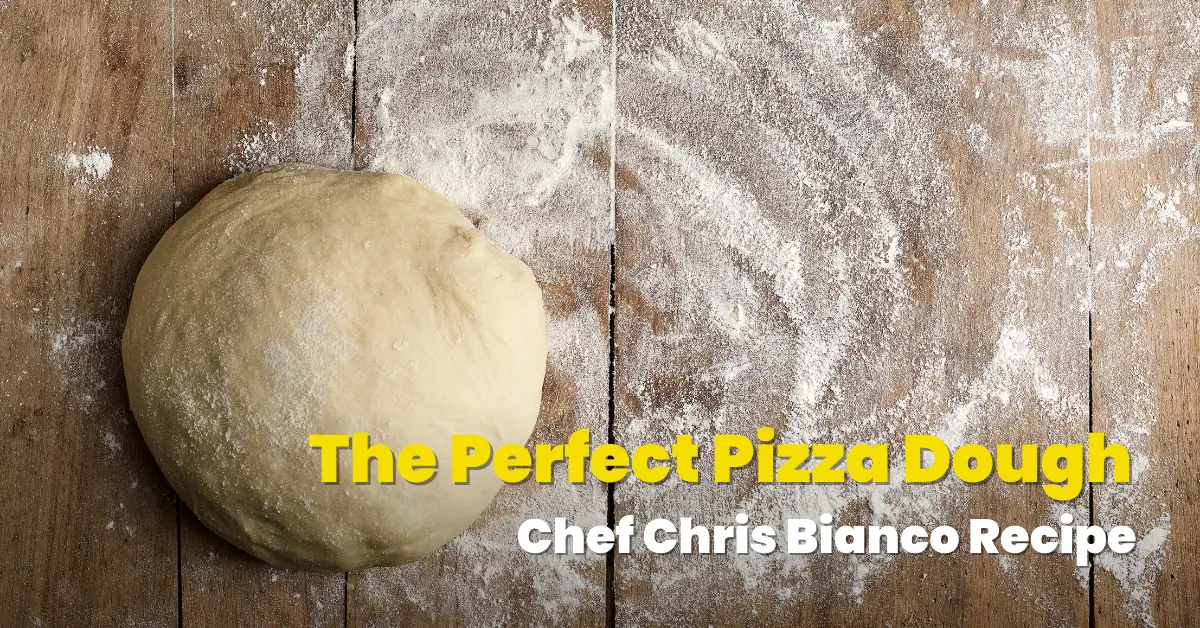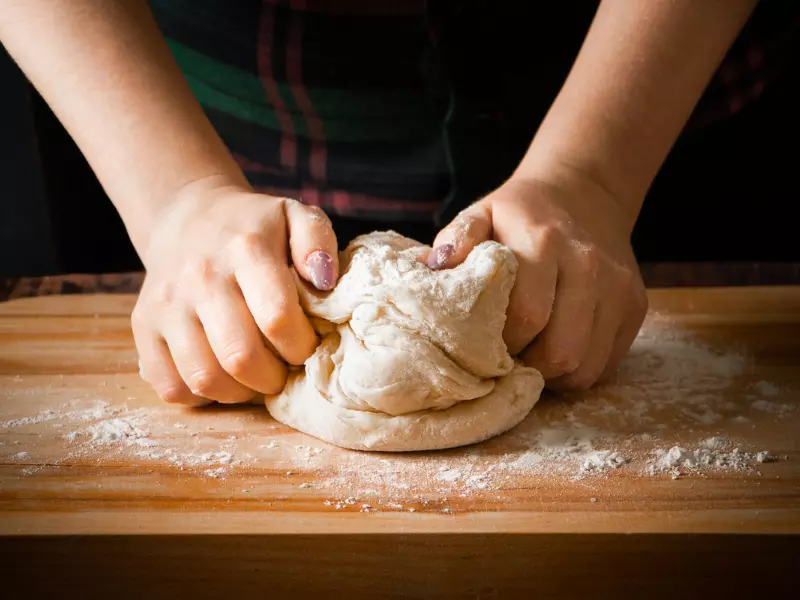Perfect Pizza Dough Recipe: Pizza Dough the Chris Bianco way!
This post may contain affiliate links. You can view our Affiliate Marketing Legal Disclaimer here.

Making your own pizza dough can be both a fun and rewarding experience. When it comes to Neapolitan-style pizza dough, the very best recipes and techniques are hands down from chef Chris Bianco. This article is the culmination of researching over 12 different sources, including Chris Bianco’s cookbook “Bianco: Pizza, Pasta, and Other Food I Like.”
My passion for pizza began as a young boy, enjoying slices at my local pizzeria. Through trial and error, and a lot of research, I learned the secrets to making great pizza dough at home.
With a few simple ingredients and a bit of patience, you too can master making pizza dough at home. Whether you’re an experienced cook or new to the kitchen, this recipe is easy to follow and yields amazing results. Let’s get to it!
Who is Chris Bianco?

Photo by PMQ Pizza Magazine. Chef Chris Bianco.
His passion for pizza began at an early age when he grew up watching his grandmother make her own homemade dough and sauces.
When Chef Chris moved to Phoenix, Arizona in 1994 he opened Pizzeria Bianco with only two tables and a wood-fired oven. Since then, Chef Chris Bianco has earned fame and notoriety in the culinary world by making some of the best pizzas around.
His unique technique of cooking with natural ingredients over a wood-fired oven sets him apart from other restaurants that use industrial ovens and pre-made dough.
His combination of traditional Neapolitan-style pizza and local Arizona flavors has delighted customers for years!
In 2003, Chef Chris Bianco won the James Beard Award making him the first pizzaiolo to be named Best Chef Southwest. He was also awarded the industry’s highest distinction when he was named Outstanding Restaurateur by the James Beard Foundation in 2022.
These achievements demonstrated that pizzaiolos could be honored alongside some of the best chefs in the nation. Bianco’s success has inspired countless pizza lovers to pursue their dreams and strive for greatness.
His passion for quality ingredients, commitment to perfection, and dedication to the craft has made him a role model for aspiring chefs everywhere. Chef Chris Bianco’s achievement is a testament to what can be accomplished with hard work and dedication.
Chris Bianco’s Pizza Dough: Step-by-Step Recipe
Video by Jimmy Kimmel Live
Written Recipe
To start making chef Chris Bianco’s famous Neapolitan-style pizza dough, you’ll need to gather some basic ingredients.
- 1 envelope of active dry yeast
- 3 cups (375 ml) of warm water (105°F to 110°F)
- 4 cups (500 gr) of bread flour (and a bit more for dusting)
- 2 teaspoons (22 gr) salt
- Extra virgin olive oil
- Large mixing bowl
- Your hands for mixing! We’re going to get messy here, but that’s the fun part of making your own pizza dough.
Step 1
Pour one-third of the water and one-third of the flour into a large mixing bowl. Take your yeast and pour that into the leftover water and sprinkle some of the flour over it. Mix the water, yeast, and flour together to activate the yeast. This is called proofing. Let that sit for about 20 minutes. While that proofing is going on, lightly mix the flour and water together with your hands. We’re looking for the flour to absorb the water. It will be very wet and sticky.
Step 2
Pour the yeast (it should be bubbling a bit) into the wet, sticky pizza dough we just made. Gently mix all the components together with your hands. At this time, add the salt while you mix. You should have a wet, tacky feeling pizza dough. Let that stand at room temperature for about 20 minutes.
Step 3
After you let it sit, you should see your pizza dough rise a bit. Now it’s time to knead the dough. Sprinkle some flour over your work area and some over the pizza dough.
Remember, this is considered a high hydration (74% hydration) pizza dough so it will be sticky and hard to work with. The real secret here is having patience with the dough and you’ll be fine.
Grab the edge of the pizza dough and fold it towards you. Then, with the palms of your hands push the pizza dough away from you. Do this step repeatedly and sprinkle some more flour if the pizza dough sticks too much to your work area. After kneading for a while, the pizza dough should still be a bit sticky but much easier to work with and way more elastic.

Take your time. Kneading the pizza dough is one of the most important steps in the process.
Step 4
Generously grease a large bowl with good quality extra virgin olive oil. You will then make a ball with your pizza dough and place it in the bowl. Make sure to get some extra virgin olive oil over it. This will help the pizza dough not stick to the bowl and prevent it from developing a skin that could later impede it from properly rising.
Let the pizza dough sit at room temperature for about an hour. Cover the bowl with plastic wrap and refrigerate for 3 hours or up to 24 hours. This step allows the dough to get some good fermentation and build lots of flavor. The longer you ferment your pizza dough, the more flavorful the final product will be.
Some pizza makers ferment their pizza dough for up to 72 hours before using it, so feel free to experiment to get your desired results.
Step 5
Your pizza dough should now have risen about twice the size. Cut smaller portions of pizza dough, about 12 ounces each, and “ball” them with your hands. This is a very important preparation step so pay close attention.
Sprinkle a bit of flour over the 12-ounce portion of pizza dough. With your hands, palms side up, push the pizza dough in and rotate. Keep doing this until you form a nice round ball of pizza dough. It should not have seams at the bottom, but rather be smooth all the way around. Do this for the rest of the pizza dough. Now you’re ready to make pizza!
Store the rest of the pizza dough balls we made in the refrigerator. These will keep in the refrigerator for about three days, but it’s best if you use them within a 48-hour period.
The best storage for your pizza dough is in a silicone container. Using a silicone container will prevent the dough from sticking while being stored in the refrigerator.
We really like these stackable silicone containers as they are perfect for holding individual portions of dough. You can also use these containers in the initial stages when you’re proofing the pizza dough.
EXTRA Flavor: Adding Herbs and Spices

Photo by orchidsandsweettea.com. Add herbs and spices to your pizza dough for an extra gourmet feeling.
An extra step you can take to make your pizza dough even more flavorful is to add herbs and spices to the mix before letting the dough sit in the refrigerator overnight. Get inspired by the flavors of Italy and add your favorite combination of herbs and spices for an extra punch of flavor.
Some popular combinations are oregano, basil, garlic, thyme, rosemary, sage, and parsley. You can also use other not-so-Italian flavors like smoked paprika, onion flakes, chili powder, black pepper, and red pepper flakes.
You now have fragrant pizza dough that’s packed with flavor!
Personally, I love adding herbs and spices to my pizza dough. The extra step goes a long way in making your final product feel just that more gourmet.
I recommend using Spiceology’s Pizza Blend seasoning when finishing off your pizza dough. This Italian seasoning adds herbs, dried vegetables, and a touch of heat. It’s also very low in sodium which is always a big plus in my kitchen.
“Don’t quit. You learn things when you burn things!”
Chef Chris Bianco
Enjoy your pizza dough adventure!
Now, you’ve got the dough down (pun intended) and the knowledge to craft a seriously delicious pizza. But remember, making pizza is a journey, not a destination.
There will be times when your dough might not rise quite as high, or your crust might char a little more than you planned. As Chef Chris Bianco himself says, “Don’t quit. You learn things when you burn things!” (cited from Chris Bianco’s cookbook, “Bianco: Pizza, Pasta, and Other Food I Like”).
Take this advice to heart. Think of these little mishaps as stepping stones to pizza mastery. Every tweak, every experiment, and every “oops!” moment brings you closer to pizza perfection. So don’t be afraid of the process!
With a little practice, a sprinkle of patience, and a whole lot of love, you’ll be a pizza dough pro in no time.

ABOUT THE AUTHOR
I'm Rufino Rosado and my love for pizza has fueled a lifelong obsession. I've devoured countless slices, experimented with every style imaginable, and even endured my fair share of kitchen disasters. But through trial and error, I've transformed my passion into expertise, mastering the art of crafting restaurant-quality pizza at home. Now, I'm here to share my hard-earned knowledge and guide you on your own pizza journey, no matter your skill level.

Share this post!

ABOUT THE AUTHOR
I'm Rufino Rosado and my love for pizza has fueled a lifelong obsession. I've devoured countless slices, experimented with every style imaginable, and even endured my fair share of kitchen disasters. But through trial and error, I've transformed my passion into expertise, mastering the art of crafting restaurant-quality pizza at home. Now, I'm here to share my hard-earned knowledge and guide you on your own pizza journey, no matter your skill level.
